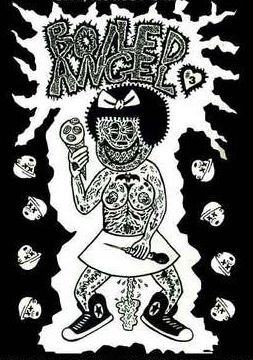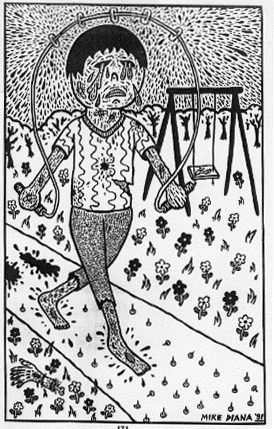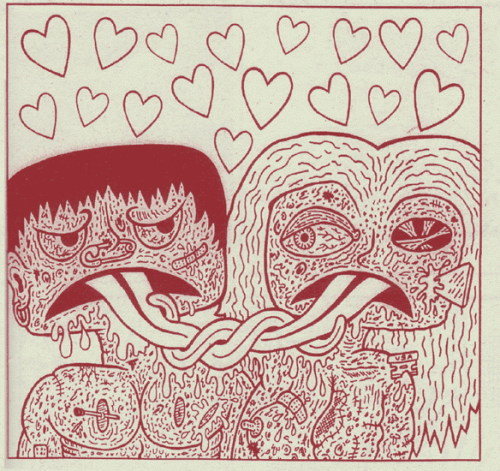Note: Steve Bissette and I are teaching a course in contemporary comics history (Survey of the Drawn Story II, as it’s properly known). Our students are required to submit an essay, in blog form, on an aspect of contemporary comics history. They are restricted to the period of 1969 – present.
Our first essay is by Ben Horak. Enjoy!
-Robyn Chapman
Contemporary Comics Spotlight: The Trial Of Mike Diana
By Ben Horak
Under the First Amendment, Freedom of Speech and Freedom of Press are constitutional rights that every American is entitled to. These rights allow us the freedom to not be censored in our speech and writings. However there are some exceptions. The First Amendment does not protect anything deemed to be obscene (harmful to society). While this exception may protect any racist hatred or child pornography, it does also limit our freedom. Such is the story of underground comic artist Mike Diana.
In 1988 nineteen-year-old Mike Diana was working as a school janitor in Largo, Florida. Diana would use the school copy machine to make his own zine that he would later distribute to friends and family. This began his now infamous zine Boiled Angel.
The zine featured short comics by Diana that parodied the topics of child abuse, incest, rape, religious corruption and murder. The term “bad taste” just begins to scratch the surface of Diana’s art. In the comic short Zero Tolerance Diana writes “My parents had warned me that I would get into trouble if I drew such gross things. I thought I had the freedom to draw and print whatever I wanted to, but no way.”
After two years and eight issues of Boiled Angel Diana received mail from an artist who was very interested in purchasing every issue. Not seeing any harm in this request, Diana obliged. What he didn’t know was that the unknown artist was actually a police officer who wanted to show Diana’s work to the courts. Shortly after sending the “artist” copies, Diana received another piece of mail. This time it was a court order for Diana charging him with three counts of obscenity (publishing, distributing and advertising obscene material).
For the trial, Diana contacted and was aided by the Comic Book Legal Defense Fund. This is a non-profit First Amendment organization for comic book artists. The CBLDF helped Diana with several defense attorneys and expert witness, all free of cost. However, after a week-long trial Diana was found guilty of producing and selling obscene work. This makes Diana the first artist ever to have a criminal conviction for obscenity.
Diana’s sentence included four days in jail, a three-year probation, fines amounting to three thousand dollars, forbidden contact with minors (which cause him to be fired from his janitorial job), thirteen thousand hours of community service, journalism ethics courses and psychiatric help. But the worst sentence of all was that Diana was not allowed to draw for personal use for the entire length of his probation. Police would have surprise warrants wherein they would enter Diana’s house and search the premises for any sketches Diana may have been drawing.
Diana and the CBLDF attempted to appeal his sentence twice to the State Appellate Court. Both of the appeals were denied. Yet on the second appeal the third obscenity charge (advertising obscene material) was appealed due to the fact that Diana advertised issue before they were actually created. The Court agreed “(it’s) improper to convict someone for advertising material that had not yet been created, since Diana could not, at the time, know the nature or character of the work.”
The Supreme Court finally denied Diana’s appeal, giving him no other option but to fulfill his sentence. Diana did however manage to move his sentencing from Florida to New York where he could serve out his community service hours by working for the CBLDF.
When reading Diana’s comics, it’s easy to see why people would see it as obscene. Yet putting his artwork in the ranks of child pornography is absurd. With child pornography, there is clearly a victim who is a minor being abused. In Diana’s artwork, no actual person is being abused or murdered. It does not matter if Diana’s comics are offensive, grotesque and offers no moral to the topics he writes about. What matters is the fact that Diana’s work needs to exist as an example that the First Amendment is in effect. If someone is prohibited from creating his or her own personal art, then no one is truly free.
– Ben Horak






Pingback: Kuchar and Comics « Fischer On Comix